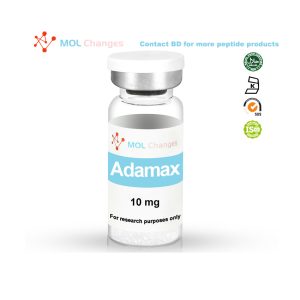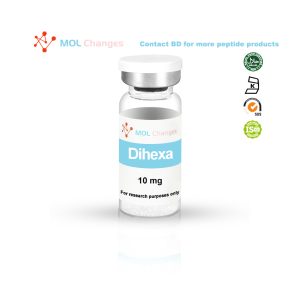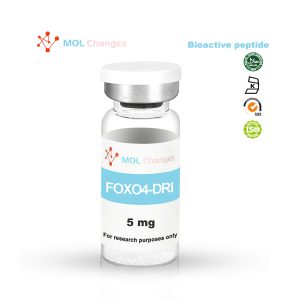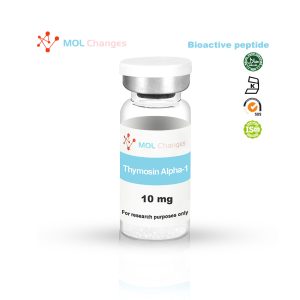Semax, which was developed in Russia, has been found to have benefit in the settings of stroke, cognitive impairment, dementia, and inflammation of the optic nerve. It has also been tested as a potential immune system booster and has been found to have antidepressant and anxiolytic properties as well. Research shows that Semax increases levels of brain-derived neurotrophic factor (BDNF) in the central nervous system as well as levels of serotonin and dopamine.
Sequence
Ac-Met-Glu-His-Phe-Pro-Gly-Pro
CAS Number
80714-61-0
Molecular Formula
C39H54N10O10S
Molecular Weight
854.99
Semax affects resting brain structure
Functional magnetic resonance imaging shows that Semax enhances the functioning of the so-called default mode network. The default mode network is a brain region that is more active at rest than during active task performance. Little is actually known about this particular network, but recent research suggests it may play a role in social cognition and environmental monitoring. It’s like a generalized system for monitoring the world around us when we don’t have a specific goal to focus on. This makes it an important component of attention because the default mode network is necessary to wake up from a “resting” state so that we can focus on events, especially those involving other people. The fact that the default mode network is often impaired in cognitive disorders such as Alzheimer’s disease further supports the idea that it is involved in general social awareness.
By promoting activity in the default mode network, Semax increases our overall level of arousal at rest. This makes us more attentive to our environment, especially our social environment, which is perceived to have greater focus and attention. In other words, Semax may be enhancing the brain’s basic environmental monitoring function, making it easier to shift from a resting state to a focused state.
It is also important to note that increased activity in the default mode network is typically associated with increased connectivity between regions of the brain. Increased interconnectivity has been associated with improved problem solving, enhanced memory, and increased creativity. Although there is no direct research to support this role for Semax, the peptide has the potential to enhance interconnectivity and thus improve brain function on a global scale.
Semax in Stroke
Semax is used in Russia for the treatment of acute cerebral hypoxia, such as in cases of stroke or traumatic brain injury. Studies in rats have found that Semax stimulates multiple molecular mechanisms of gene transcription in the central nervous system (CNS). Specifically, Semax stimulates changes in the expression of 24 different genes associated with blood vessel function in the brain and spinal cord. These genes regulate everything from smooth muscle cell migration to red blood cell formation and neoangiogenesis. This correlation could explain why Semax shows neuroprotective properties in the case of stroke. The peptide appears to promote neuronal survival, stabilize mitochondria, which stabilizes energy production, and improve nutrient supply to the brain.
Studies conducted in Russia with patients involved in rehabilitation after stroke have shown that Semax accelerates the rate of functional recovery and improves the overall level of functioning upon completion of treatment. According to Gusev et al. et al, “Early rehabilitation and the use of Semax increased BDNF plasma levels, accelerated functional recovery, and improved motor performance.”
BDNF is a naturally occurring brain peptide that stimulates learning and memory.Semax has the potential to improve neuroplasticity in the brain by stimulating BDNF and making it easier for undamaged areas of the brain to learn tasks previously handled by damaged areas.Semax also activates the Default Mode Network, which, as mentioned above, is a key component of restful attention and social functioning.
Semax and Gene Expression in the Brain
Changes in gene expression in the brain secondary to Semax are not only seen in the context of stroke. Studies in healthy rats have shown that a single intranasal administration of Semax can affect many different genes in the hippocampus and frontal cortex. This is important because the hippocampus plays a key role in memory and learning, while the frontal cortex plays an important role in attentional focus, planning and organizing information. In both tissues, gene expression is observed within 20 minutes of Semax administration and has a particularly potent effect on nerve growth factor (NGF) and BDNF. As explained in the next section, Semax’s effects on genes in areas of the brain responsible for focusing attention, learning, and executive function are one of the reasons why researchers hypothesize that the peptide could open up avenues for exploring how we learn and process information. It’s even hoped that Semax will help us understand how to improve cognitive performance and make learning easier and more sustainable for everyone.
Semax and Cognitive Performance
There is reason to believe that Semax is an effective way to promote learning and memory, especially for individuals suffering from neurological impairments in these functions. According to studies in Canada, the U.S. and China, ACTH, the natural protein on which Semax is based, protects learning and memory function in mouse models of epilepsy. The protein has long been used in the treatment of epilepsy as a first-line defense against developmental arrest or degeneration.
According to Dr. Scantlebury, Semax is a very potent derivative of ACTH that may have benefits not found in natural peptides. Although more research is needed, he noted that ACTH, even at low doses, may prevent learning and memory dysfunction during seizures. In turn, this may indicate that ACTH and Semax have pro-intellectual properties that not only counteract learning and memory deficits in disease settings, but also improve cognitive performance if taken regularly at low doses.
Orgasm and Depression
Studies in mice have shown that increased levels of BDNF help to regulate brain function in people with depression. Current antidepressants, such as SSRIs, tend to indirectly affect serotonin signaling in the brain for effect, but it usually takes several weeks of treatment to see results. For years, this has created a paradox for scientists studying brain chemistry, since their effects should be more direct. Now, thanks to insights gained from Semax and other BDNF-stimulating proteins, SSRIs may take a long time to work because their actual therapeutic effects are related to their ability to increase BDNF levels and thus stimulate neurogenesis in the depressed brain. If this is true, it would open up a whole new way of understanding depression and its treatment. According to Deltal et al. et al. there is good reason to be thankful that combining BDNF stimulants (such as Semax) with SSRI treatment could greatly improve efficacy and make the treatment of depression easier. Of course, much research is needed to determine whether these results can be replicated and extended
COA
HPLC
MS
- I. S. Lebedeva et al., “Effects of Semax on the Default Mode Network of the Brain,” Bull. Exp. Biol. Med., vol. 165, no. 5, pp. 653–656, Sep. 2018. [PubMed]
- R. B. Mars, F.-X. Neubert, M. P. Noonan, J. Sallet, I. Toni, and M. F. S. Rushworth, “On the relationship between the ‘default mode network’ and the ‘social brain,’” Front. Hum. Neurosci., vol. 6, 2012. [PMC]
- E. V. Medvedeva et al., “The peptide semax affects the expression of genes related to the immune and vascular systems in rat brain focal ischemia: genome-wide transcriptional analysis,” BMC Genomics, vol. 15, p. 228, Mar. 2014. [PubMed]
- E. I. Gusev, M. Y. Martynov, E. V. Kostenko, L. V. Petrova, and S. N. Bobyreva, “[The efficacy of semax in the tretament of patients at different stages of ischemic stroke],” Zh. Nevrol. Psikhiatr. Im. S. S. Korsakova, vol. 118, no. 3. Vyp. 2, pp. 61–68, 2018. [PubMed]
- T. I. Agapova et al., “[Effect of semax on the temporary dynamics of brain-derived neurotrophic factor and nerve growth factor gene expression in the rat hippocampus and frontal cortex],” Mol. Genet. Mikrobiol. Virusol., no. 3, pp. 28–32, 2008. [PubMed]
- M. H. Scantlebury, K.-C. Chun, S.-C. Ma, J. M. Rho, and D. Y. Kim, “Adrenocorticotropic Hormone Protects Learning and Memory Function in Epileptic Kcna1-null mice,” Neurosci. Lett., vol. 645, pp. 14–18, Apr. 2017. [PubMed]
- T. Deltheil et al., “Behavioral and serotonergic consequences of decreasing or increasing hippocampus brain-derived neurotrophic factor protein levels in mice,” Neuropharmacology, vol. 55, no. 6, pp. 1006–1014, Nov. 2008. [PubMed]
- Ivanov, Alexander & Bobyntsev, Igor & Shepeleva, Olga & Kryukov, Alexey & Andreeva, L & Myasoedov, N. (2017). Influence of ACTG4-7-PGP (Semax) on Morphofunctional State of Hepatocytes in Chronic Emotional and Painful Stress. Bulletin of experimental biology and medicine. 163. [Research Gate]
- Bobyntsev, Igor & Kryukov, Alexey & Shepeleva, Olga & Ivanov, Alexander. (2015). The effect of ACTH-4-7-PGP peptide on lipid peroxidation in liver and activity of serum transaminases in rats under acute and chronic immobilization stress conditions. 78. 18-21. [Research Gate]
Article/Literature Citation Notes
The purpose of quoting the scientist and professor's article is to acknowledge, recognise and applaud the exhaustive development work that has been done to undertake this peptide research. The scientist does not in any way support or advocate the purchase, sale or use of this product for any reason, and MOL Changes has no affiliation or relationship, implied or otherwise, with the scientist.
warning
These products are intended for scientific purposes only for in vitro research and are not to be used for human, animal or unethical experiments, in vitro research (Latin: in glass) is conducted in vitro. These products are not drugs and are not approved by the Food and Drug Administration in any country for the prevention, treatment or cure of any medical condition, disease or illness. The introduction of this product into humans or animals in any form is strictly prohibited by law.






